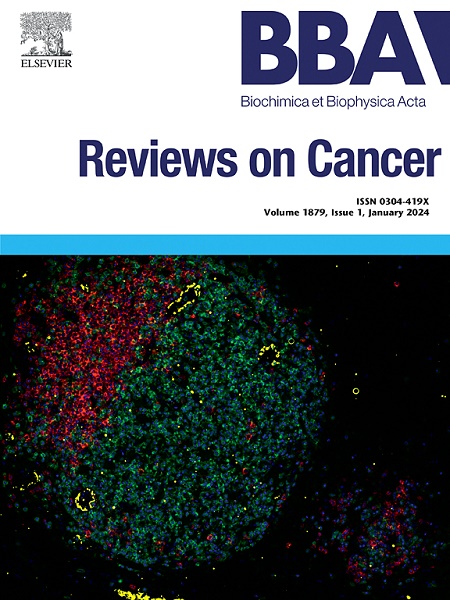癌症恶病质的机理和靶向治疗策略。
IF 9.7
1区 医学
Q1 BIOCHEMISTRY & MOLECULAR BIOLOGY
Biochimica et biophysica acta. Reviews on cancer
Pub Date : 2024-11-01
DOI:10.1016/j.bbcan.2024.189208
引用次数: 0
摘要
肿瘤恶病质是一种多因素综合征,其特点是全身功能失调,包括厌食和体重严重下降,对标准营养干预措施产生抗药性。据估计,约有 20% 的癌症患者在疾病后期会因恶病质而死亡。因此,了解其发病机制对于改善治疗效果至关重要。近期的研究重点是恶病质中能量摄入和消耗的失衡。在临床上,恶病质表现为厌食、脂肪组织萎缩和骨骼肌萎缩,每种情况都由不同的机制驱动。厌食主要是由于肿瘤分泌的因子和癌症诱发的激素紊乱损害了下丘脑对食欲的调节。脂肪组织萎缩主要是由于脂肪甘油三酯脂肪酶和激素敏感脂肪酶等酶的活性增强,同时脂蛋白脂肪酶的活性降低,导致脂肪分解作用增强。解偶联蛋白 1 促进白色脂肪组织褐变,通过增加能量消耗进一步加速脂肪分解。骨骼肌萎缩是恶病质的一个特征,它是通过泛素-蛋白酶体和自噬-溶酶体途径以及线粒体功能障碍导致蛋白质周转失调的结果。此外,化疗也会加剧恶病质。这篇综述探讨了癌症恶病质的分子机制,并讨论了当前的治疗策略,旨在为未来的研究提供信息并改进治疗方法。本文章由计算机程序翻译,如有差异,请以英文原文为准。
Mechanisms of cancer cachexia and targeted therapeutic strategies
Tumor cachexia is a multifactorial syndrome characterized by systemic dysfunction, including anorexia and severe weight loss that is resistant to standard nutritional interventions. It is estimated that approximately 20 % of cancer patients succumb to cachexia in the later stages of their disease. Thus, understanding its pathogenesis is vital for improving therapeutic outcomes. Recent research has focused on the imbalance between energy intake and expenditure in cachexia. Clinically, cachexia presents with anorexia, adipose tissue atrophy, and skeletal muscle wasting, each driven by distinct mechanisms. Anorexia arises primarily from tumor-secreted factors and cancer-induced hormonal disruptions that impair hypothalamic regulation of appetite. Adipose tissue atrophy is largely attributed to enhanced lipolysis, driven by increased activity of enzymes such as adipose triglyceride lipase and hormone-sensitive lipase, coupled with decreased lipoprotein lipase activity. The browning of white adipose tissue, facilitated by uncoupling protein 1, further accelerates fat breakdown by increasing energy expenditure. Skeletal muscle atrophy, a hallmark of cachexia, results from dysregulated protein turnover via the ubiquitin-proteasome and autophagy-lysosomal pathways, as well as mitochondrial dysfunction. Additionally, chemotherapy can exacerbate cachexia. This review examines the molecular mechanisms underlying cancer cachexia and discusses current therapeutic strategies, aiming to inform future research and improve treatment approaches.
求助全文
通过发布文献求助,成功后即可免费获取论文全文。
去求助
来源期刊

Biochimica et biophysica acta. Reviews on cancer
医学-生化与分子生物学
CiteScore
17.20
自引率
0.00%
发文量
138
审稿时长
33 days
期刊介绍:
Biochimica et Biophysica Acta (BBA) - Reviews on Cancer encompasses the entirety of cancer biology and biochemistry, emphasizing oncogenes and tumor suppressor genes, growth-related cell cycle control signaling, carcinogenesis mechanisms, cell transformation, immunologic control mechanisms, genetics of human (mammalian) cancer, control of cell proliferation, genetic and molecular control of organismic development, rational anti-tumor drug design. It publishes mini-reviews and full reviews.
 求助内容:
求助内容: 应助结果提醒方式:
应助结果提醒方式:


